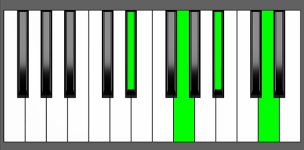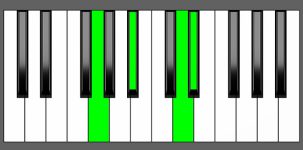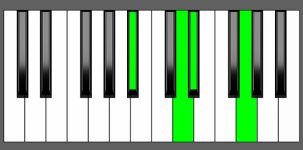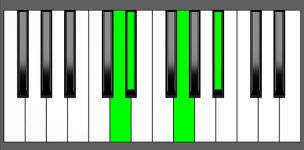Piano Diagram of Eb Maj7 in Root Position
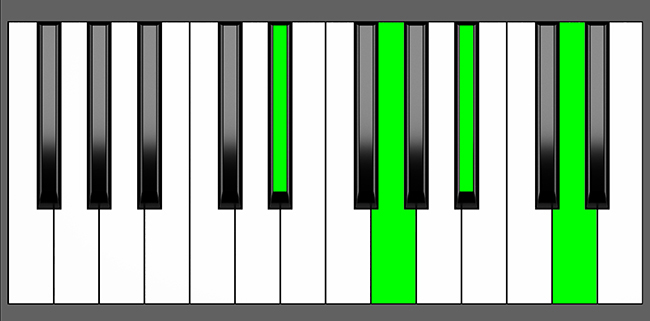
Eb Maj7 is essentially a major triad based on the key of Eb, with an additional major 7th (D). Eb Maj7 can be found on the first and fourth degrees in major keys, and on the third and sixth in minor keys. Keep reading to get a better grip on the music theory behind this chord.
Structure of Eb Maj7
Notes |
|---|
| Eb, G, Bb, D |
Intervals |
|---|
| R, 3, 5, 7 |
Fingers Position
Left Hand |
|---|
| 5, 3, 2, 1 |
Right Hand |
|---|
| 1, 2, 3, 5 |
Eb Maj7 Chord Inversions
The Eb Maj7 chord has a total of 3 inversions:
| Root Position: | Eb | G | Bb | D |
| 1st Inversion: | G | Bb | D | Eb |
| 2nd Inversion: | Bb | D | Eb | G |
| 3rd Inversion: | D | Eb | G | Bb |
Piano Keyboard Diagrams
Music Theory and Harmony of Eb Maj7
What are Major 7th Chords?
A major seventh chord is a type of chord that consists of a major triad with an additional major seventh interval. It can be found as “maj7,” “M7,” or “Δ”. Maj7 chords have a lush and dreamy sound and can be used as substitutes for tonic and subdominant chords in major keys.
Building the Eb Maj7 Chord: Different Approaches
Starting from the Eb Major Scale:
To build a major 7th chord, you can use the major scale as a reference. You will need to combine a Root, a major 3rd, a 5th interval, and a major 7th.
For instance, to build the Eb Maj7 chord, you can start with the Eb Major scale, which consists of Eb, F, G, Ab, Bb, C, and D.


To form an Eb Maj7 chord, use the formula R, 3, 5, 7 as follows:
- Start with the Root note, Eb.
- Choose the major 3rd interval, G.
- Add the 5th interval, which is Bb.
- Lastly, include the major 7th interval, D.
By using this straightforward formula, you can produce a major 7th chord from any major scale.
by Combining Intervals:
One method to create a major 7th chord is by combining specific intervals – a major 3rd, a minor 3rd, and again a major 3rd. To illustrate, let’s use the Eb Maj7 chord as an example.
3 + m3 + 3 = Major 7th Chords
By examining the intervals between the notes, we can see that Eb-G forms a major 3rd interval, G-Bb creates a minor 3rd interval and Bb-D is also a major 3rd. These three intervals can be stacked together to create the Eb Maj7 chord.
How to Use Eb Maj7 in a Chord Progression
These tables display the harmonized major and natural minor scales where you can find an Eb Maj7 chord.
In the context of major scales, the Eb Maj7 chord functions as the tonic chord (I) in the key of Eb. Additionally, it can also be used as the subdominant chord in the Bb major scale.
In natural minor scales, the Eb Maj7 chord assumes different roles. It acts as the mediant chord in the C natural minor scale and as the submediant chord in the G natural minor scale.
on Major Scales
| Major Scales | I | ii | iii | IV | V | vi | vii |
|---|---|---|---|---|---|---|---|
| Eb | Eb Maj7 | F min7 | G min7 | Ab Maj7 | Bb7 | C min7 | Dm7b5 |
| Bb | Bb Maj7 | C min7 | D min7 | Eb Maj7 | F7 | G min7 | Am7b5 |
- Tonic chord in Eb Major
- Subdominant chord in Bb Major
on Natural minor Scales
| Minor Scales | i | ii | III | iv | v | VI | VII |
|---|---|---|---|---|---|---|---|
| C | C min7 | Dm7b5 | Eb Maj7 | F min7 | G min7 | Ab Maj7 | Bb7 |
| G | G min7 | Am7b5 | Bb Maj7 | C min7 | D min7 | Eb Maj7 | F7 |
- Mediant chord in C minor
- Submediant chord in G minor
Eb Maj7 Chord Function in Major and Minor Keys
Understanding Scale Degrees
When we build chords from a scale, each note is assigned a specific degree that reflects its position within the scale. These degrees serve as a map for navigating the harmonic landscape of the music.
- Starting with the first degree of the scale, we have the Tonic chord, which establishes the tonal center of the music. This chord provides a sense of stability and grounding, serving as a reference point for all other chords and notes in the scale.
- Moving on to the second degree, we have the Supertonic, which acts as a transitional note between the tonic and other notes in the scale. This degree adds movement and tension to the music, creating a sense of forward motion and development.
- The third degree is the Mediant, which is located halfway between the tonic and dominant notes. This degree helps to establish the mode of the scale (major or minor) and plays a crucial role in defining the emotional character of the music.
- The fourth degree is the Subdominant, which acts as a counterpart to the dominant. This degree creates a sense of tension and release, adding depth and complexity to the harmonic structure of the music.
- The fifth degree is the Dominant, which generates a sense of tension and anticipation. This chord is often used as a launching pad for resolving back to the tonic, creating a sense of closure and completion.
- Moving on to the sixth degree, we have the Submediant, which provides a sense of relaxation and stability. This degree is often used as a transition between the dominant and tonic, creating a sense of balance and resolution.
- Finally, we have the seventh degree, the Leading tone, which creates a sense of tension and dissonance. This degree wants to resolve to the tonic, creating a feeling of resolution and finality.
Eb Maj7 as the Tonic Chord in Eb Major
Eb Maj7 is the first chord in the harmonized Eb major scale. In a major key, the I chord (built on the first degree of the scale) serves as the tonic chord, providing the harmonic center of the chord progression. If we take the Eb major scale (Eb, F, G, Ab, Bb, C, D) and harmonize it using the notes of the scale, we get the following chords:
| I | ii | iii | IV | V | vi | vii |
| Eb Maj7 | Fmin7 | G min7 | Ab Maj7 | Bb7 | C min7 | Dm7b5 |
Eb Maj7 Chord Progressions as I degree
Try playing these chord progressions to get an idea of how Eb Maj7 functions as the tonic (I degree) in a chord progression.
II V I
| ii | V | I |
| F min7 | Bb7 | Eb Maj7 |
Circle Progression
| vi | ii | V | I | IV | vii | iii7 | vi |
| C min7 | F min7 | Bb7 | Eb Maj7 | Ab Maj7 | Dm7b5 | G7 | C min7 |
Eb Maj7 as Subdominant Chord in Bb Major
Eb Maj7 can also be found on the fourth degree of the Bb major scale. In the I-IV-V progression, the chord on the fourth degree serves as a transitional chord between the first and fifth degrees.
| I | ii | iii | IV | V | vi | vii |
| Bb Maj7 | Cm7b5 | D min7 | Eb Maj7 | F7 | G min7 | Am7b5 |
Eb Maj7 as IV degree – Chord Progressions
Try playing these chord progressions to get an idea of how Eb Maj7 functions as the subdominant (IV degree) in a chord progression.
I IV V
| I | IV | V |
| Bb Maj7 | Eb Maj7 | F7 |
Circle Progression
| vi | ii | V | I | IV | vii | iii7 | vi |
| G min7 | C min7 | F7 | Bb Maj7 | Eb Maj7 | Am7b5 | D7 | G min7 |
Eb Maj7 as the Mediant Chord in C Minor
Likewise, if we consider the C natural minor scale (C, D, Eb, F, G, Ab, Bb), we can locate Eb Maj7 on the third degree.
| i | ii | III | iv | v | VI | VII |
| C min7 | Dm7b5 | Eb Maj7 | F min7 | G min7 | Ab Maj7 | Bb7 |
Eb Maj7 as III degree – Chord Progressions
These chord progressions can help you comprehend how Eb Maj7 serves as the mediant (III degree).
i III
| i | III |
| C min7 | Eb Maj7 |
i III VII VI
| i | III | VII | VI |
| C min7 | Eb Maj7 | Bb7 | Ab Maj7 |
Eb Maj7 as the Submediant Chord in G Minor
Another instance where you can come across an Eb Maj7 chord is while playing in the key of G minor. In fact, Eb Maj7 can be found on the sixth degree of the G minor scale.
| i | ii | III | iv | v | VI | VII |
| G min7 | Am7b5 | Bb Maj7 | C min7 | D min7 | Eb Maj7 | F7 |
Eb Maj7 as VI degree – Chord Progressions
Try playing these chord progressions to get a sense of how Eb Maj7 sounds as the submediant (VI degree).
i VI VII
| i | VI | VII |
| G min7 | Eb Maj7 | F7 |
i v VI VII
| i | v | VI | VII |
| G min7 | D min7 | Eb Maj7 | F7 |
i III VII VI
| i | III | VII | VI |
| G min7 | Bb Maj7 | F7 | Eb Maj7 |
Alternative Names for Eb Maj7 Chord
- Ebj7
- Eb∆
- EbΔ7
- Mib∆
- Mib7+
- EbM7
- EbMa7
- Eb Maj7
- Eb Major 7
- Mib Magg7
Conclusion
The chord progressions and examples presented in this post provide a comprehensive overview of the most common uses of the Eb Maj7 chord. It’s important to note, however, that many advanced harmony-related topics could not be included due to space constraints. These topics include chord progressions built on harmonic and melodic scales, modal scales, hidden tonality, secondary dominants and other chord substitutions, non-functional harmony and atonal music, modal interchange and borrowed chords, voice leading and counterpoint, chromatisms, jazz harmony…I mean, music theory is a huge topic!
Although I couldn’t cover all of these topics in my post, I encourage readers to continue exploring these areas in their own study and research. By expanding your knowledge in these advanced areas of music theory, you can gain a deeper understanding of the harmonic possibilities that exist beyond the basics presented here.
